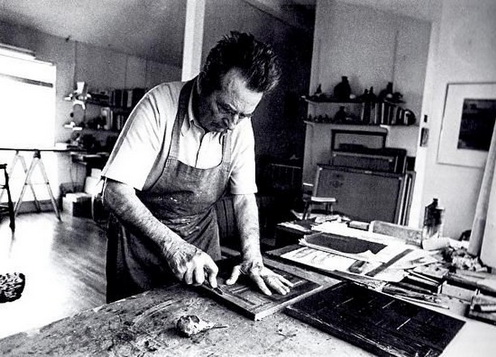 |
Werner Drewes | |
| Birth Date: July 27, 1899 |
||
| Death Date: June 21, 1985 Artist Gallery |
||
| Werner Drewes was born in Canig, Germany in 1899 and showed talent in painting and woodblock printing from a young age. When drafted into the German army and serving on the front line in France until the end of the war, he said that the horrors of life at the front were only made tolerable by his sketchbook and some reading materials.
Drewes studied architecture at the Technische Hochschule in Berlin-Charlottenburg and at the Stuttgart School of Arts and Crafts. In 1921, he was admitted to the Bauhaus (Weimar) where he studied design under artists such as Klee, Itten, and Muche. Traveling was an important source of inspiration for Drewes' work, and he traveled extensively from 1924 to 1927. His first trip was throughout Italy and Spain to study classical artists such as Tintoretto, Velasque, and El Greco, selling work from his exhibits and taking portrait commissions to fund his travel. He then journeyed throughout South America, North America, and Asia, returning to Germany in 1927. He resumed studying at Bauhaus, this time at its new location in Dessau, where he studied with Lyonel Feininger (prints) and Wassily Kandinsky (painting).
In 1930, Drewes became a U.S. citizen and immigrated to New York City with his family. Under Hitler, Germany had become too restrictive an environment for abstract artists and Drewes found the political pressure unbearable. In New York City, Drewes joined other Bauhaus artists such as Mondrian and Feininger and, in contrast to his time in Germany, was able to earn a living as a professional artist. From the outset, his work caught the attention of New York art critics, including those from the New York Times and New York Sun. Along with other artists, Drewes founded the American Abstract Artists group, considered the originators of American abstraction. He also worked with Hayter's Atelier 17 in New York City to improve the intaglio printmaking technique in color.
From 1937 to 1940, Drewes taught painting, drawing, and printmaking at Columbia University, leaving to work for a year as a Director for the Graphic Arts Project of the WPA. Through the WPA, Drewes worked on the design of the 1939 Worlds Fair building. He also exhibited in various places such as the Museum of Modern Art and the Kleeman Gallery. From 1946-1965, he taught at various places, including the Institute of Design in Chicago and Washington University in St. Louis, Missouri. This period of his life saw him being more creative and productive, further fine-tuning his unique printmaking techniques and use of color.
After retiring in 1965, he moved to Pennsylvania, where abstract still lifes and landscapes define this era of his artistic production. In 1972, Drewes moved to Virginia, where he taught as a visiting Professor at George Mason Community College. Arthritis forced a new form of artistic expression: cut-out collages to add to his still growing collection of oils and prints. The Rose Catalog of his prints was published and several videos were taped of him discussing his ideas and methods. He continued to show at major galleries in Germany, Turkey, and in the United States. The Smithsonian held a solo exhibit of his work in 1985, celebrating his 65 years as a printmaker. To the very end, even suffering from arthritis, he cut his multiple plate color woodcuts, rubbed his prints by hand with a stylus, and added stylistic innovations. A prolific printmaker, Drewes produced around 732 prints in etching, drypoint, woodcut, and more during his lifetime. Through his painting, printmaking, and teaching, Drewes introduced the groundbreaking concepts of the Bauhaus to the United States —- one of the first artists to do so, influencing the development of modern art.
|
||


